You are here
European eel
The European eel (Anguilla anguilla (Linnaeus, 1758)) has a wide distribution which stretches from Northern Europe in Iceland and Norway over the Mediterranean to Northern Africa. It is a catadromous fish species: eels grow in coastal and freshwater habitats but spawn at sea. To date, the exact spawning location remains unknown but is assumed to be located in the Sargasso Sea, an area in the Atlantic Ocean. This assumption is made since the youngest eel stage has been observed in that area: the leptocephalus larvae. These larvae drift with currents towards continental Europe and once they reached the continental shelf they metamorphose into transparent glass eels. This life stage settles in coastal and freshwater habitats and grows as yellow eels. After a couple of years, having accumulated sufficient energy reserves, they migrate back into the sea as silver eels and start their migration towards the spawning grounds to spawn and die.
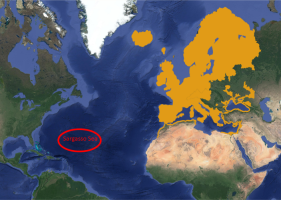
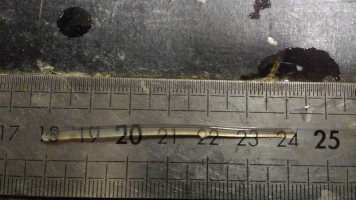
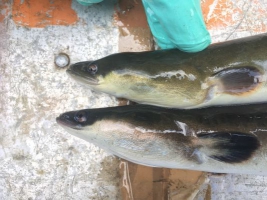
Left: The European eel is distributed throughout Europe (orange-filled shape) and presumably spawns somewhere in the Sargasso Sea (red ellipse) (distribution data are obtained by IUCN). - Middle: Glass eels arrive in Belgium during winter and spring (©Pieterjan Verhelst). - Right: Yellow eels are the sedentary life stage and characterized by their yellow-greenish colour. They migrate back to sea as silver eels and are characterized by a silver-white belly, dark back and enlarged eyes and pectoral fins (©Pieterjan Verhelst).
Since the 1970s, the recruitment of the European eel has declined by 90 - 99 %, leading to the critically endangered status of the European eel under the IUCN Red List and resulting into the European Eel Regulation in 2007. The latter states that all European member states need to take management actions to restore the population. However, this is not a simple task since many anthropogenic factors contribute to the population decline such as climate change, fisheries, habitat loss and fragmentation, introduction of non-native species and pollution.
To aid European eel management, we need a better understanding of the ecology of the European eel. Telemetry is an excellent technique to cover several fundamental knowledge gaps. The technique allows to study the movement behaviour of eels during crucial life stages such as silver eel spawning migration. During their migration, silver eels are prone to migration barriers like sluices, pumping stations and hydropower stations. Even more, major parts of their migration routes and behaviour are still unknown, especially at sea. Mapping the migration routes of European eels and understanding their migration behaviour can teach us how eels handle their available bio-energy budgets for successful spawning and what potential bottlenecks (e.g. delays near migration barriers, effects of pollution and infection by non-native parasites) may jeopardize successful migration and consequently spawning. Consequently, the acquired knowledge through telemetry can aid cost-efficient management by creating innovative solutions to facilitate migration.
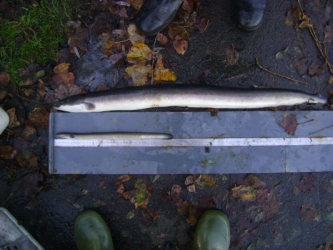
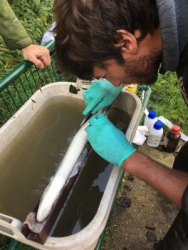
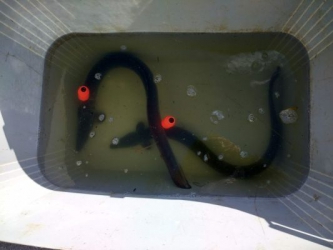
Left: Eels show sexual dimorphism, with female silver eels (upper a 93 cm long female) growing much larger than males (lower a 38 cm male), which do not exceed 45 cm total length (©Pieterjan Verhelst). - Middle: An acoustic transmitter is placed in the abdominal cavity of a sedated eel (©Pieterjan Verhelst). - Right: Silver eels tagged with a pDST tag, ready to release (©Pieterjan Verhelst).
Within the framework of the Permanent Belgian Acoustic Receiver Network (PBARN), eels are tagged with acoustic transmitters, which can be detected by the elaborated acoustic tracking network, and pop-off data storage tags (pDSTs) in the framework of the European LifeWatch project. The pDSTs record temperature and pressure and pop off after a predefined time (6 or 12 months). If you would find a tag, please contact us (Pieterjan.Verhelst@UGent.be or jan.reubens@vliz.be) so we can retrieve the tag and the valuable information it contains.
So far 392 European eels have been tagged with acoustic tags and 102 with pDSTs in the LifeWatch network.
Useful links:
